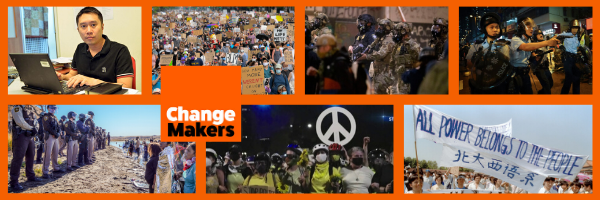Police and protests – is something changing?

For the last 10 days in Portland Oregon, Federal law enforcement have been arresting protesters. After over 50 days of sustained #BlackLivesMatter protest, the Federal Attorney General called in law enforcements over the top of state authorities under the guise of protecting property and restoring order. Federal officials have used less-lethal munitions like tear gas and also conducted arrests, firstly at protest sites and more recently tracking down protesters at their homes and as they walked the streets. The move is unprecedented, so shocking and unusual that the US State of Oregon has filed a lawsuit against the federal government accusing it of unlawfully detaining protesters.
In Delhi, between December 2019 to March 2020, an explosive movement in defense of human rights sought to stop a new national ‘Citizenship Act’ that explicitly denied rights to minority communities like Muslims. There were sustained protests in response that were violently targeted by weapon wilding vigilantees. To the shock of the watching public, the police did not intervene. President Modi did not comment on what happened, and oversaw the passing of this legislation in March 2020. In this past month under the cover of COVID, protesters have been detained by police.
In Hong Kong, between June and December 2019, we witnessed one of the largest protest movements ever staged. Hong Kongers resisted an Extradition Bill while trying to win broader democratic freedoms. Repeated demonstrations of 1 and 2 million people were coupled with a more miliant movement of anonymous Braves that moved like water in a cat and mouse battle with police. Police used excessive force, firing over 6000 rounds of tear gas between June and November 2019. Police violence saw a journalist lose her eye to a rubber bullet, protesters were subject to mass arrest, and police have even been accused of murdering protesters like Chan Yin-lam who died in circumstances that looked like suicide.
While we might be unsure of what to call it – authoritarianism, despotism, protofacism – democratic rights such as freedom of assembly and expression are dramatically under threat. This isn’t a US thing, it’s a global thing, and we need to closely examine what is driving it so that we can do something about it.
One thing that we sometimes miss is how this crackdown occurs. Again and again certain parts of the police force have played critical roles in attacking democratic rights.
Protesters often see police as a homogenous blob. Protesters engaged in frontline, more militant tactics, often have terrible stories to tell. But look more closely at more recent protester-police flashpoints and we can see a more differentiated set of police forces protecting the state.
In the US, #BlackLivesMatter has given rise to a battle between local police and federal police. Going back a month in Washington DC, President Trump deployed prison guards over the top of the local police force. In Hong Kong, the National Security Law takes over ultimate legal authority, effectively ending Hong Kong’s relative autonomy, distinctive rule of law and the power of local police.
The battleground for how we contest the state is changing. Those at the frontline provide us some lessons about how to confront it.
First, multi-winged movements with multiple theories of change are stronger than movements that play just one song. The Hong Kong Protesters and #BlackLivesMatter are an alignment of movements with really different approaches to change. In Hong Kong it was the peacefuls and the braves, in BlackLivesMatter the vast network includes occupiers and protesters, broad prefigurative visions and campaigners focused on specific demands.
Too often people think that a single approach must be right. But in today’s context, all approaches are needed. The challenge is getting different people to work together.
Second, we need to be creative about our allies. In Oregon, protesters are being supported by the state. In Hong Kong the movement’s greatest allies are lawyers and pan democrat politicians. Purist social movement postures don’t build power. As large nation states galvanise their authority, protesters need nimble, unusual local and global alliances in response. While we don’t want lowest common denominator demands, we need broad and creative support.
Finally, we need to be creative. 2020 has created a different political environment. Economic crisis, health crisis, climate crisis and democratic crisis change the terrain for how change is made and who it’s made with. Rather than just relying on what we have done or seen before, this is a moment for trying new things, for calculated risk, for learning – and for sharing our insights.
India, Hong Kong and the US show us that the stakes are high. The challenge is for us to make change anew.
Amanda Tattersall
Join our weekly email list to hear our latest musings, podcasts and training. Click on this button to subscribe:





